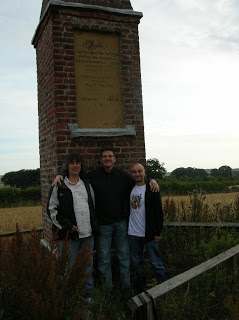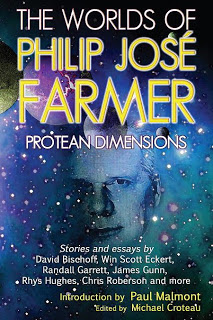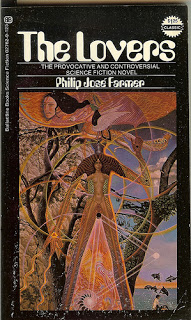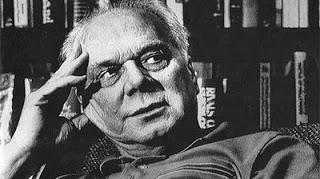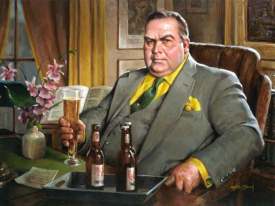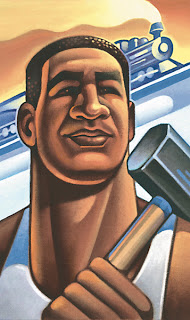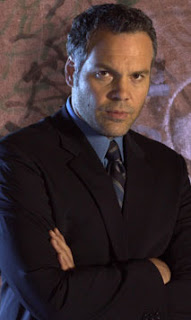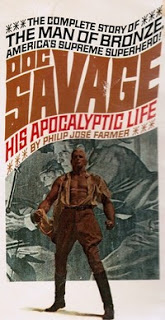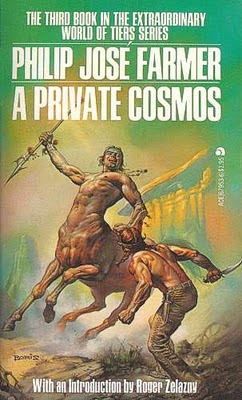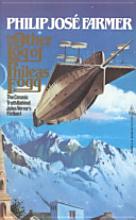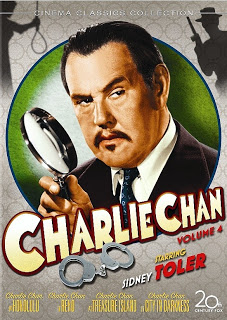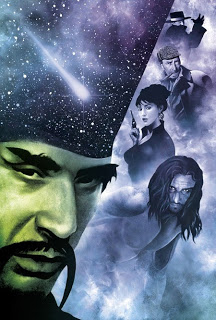Win Scott Eckert © 2008-2010
Farmerphile no. 11
Paul Spiteri and Win Scott Eckert, eds., Michael Croteau, publisher, January 2008
Trunks and Branches: The Wold Newton Family
by Win Scott Eckert
Long time Farmerphile readers will recall the first issue in which I reviewed the origins
of Philip José Farmer’s Wold Newton Family, covered the Wold Newton meteor strike in 1795
which exposed nearby coach passengers to ionized radiation, and discussed Phil’s genealogical
researches into the amazing descendents of those coach passengers, a group of supermen and
superwomen known collectively as the “Wold Newton Family” (“A Nova of Genetic Splendor,”
Farmerphile no. 1, July 2005).
Phil also included extraordinary characters who pre-date the meteor strike under the
umbrella of the Wold Newton Family, adding them as antecedents of the coach passengers. One
such is Robert E. Howard’s Solomon Kane. Another character who Phil included in the extended
Family, but is not directly descended from the coach passengers, is H. Rider Haggard’s famous
hunter, Allan Quatermain.
Some better-known characters in Phil’s Wold Newton Family, as outlined in Tarzan
Alive and Doc Savage: His Apocalyptic Life, include Captain Blood (another pre-meteor strike
ancestor); The Scarlet Pimpernel (present at meteor strike); Fitzwilliam Darcy and his wife,
Elizabeth Bennet (present at meteor strike); Harry Flashman; Sherlock Holmes and his nemesis
Professor Moriarty (aka Captain Nemo); Phileas Fogg; The Time Traveler; A.J. Raffles;
Professor Challenger; Arsène Lupin; Richard Hannay; Bulldog Drummond; the evil Fu Manchu
and his adversary, Sir Denis Nayland Smith; G-8; The Shadow; Sam Spade; The Spider; Nero
Wolfe; Mr. Moto; The Avenger; Philip Marlowe; James Bond; Lew Archer; and Travis McGee.
Adding characters to the Wold Newton Family is an entertaining exercise. It is also a
messy and creative process; the criteria are not nearly as clear-cut as when determining whether
a crossover story is valid for purposes of Wold Newton Universe continuity.
First and foremost, one must ensure that the addition to the Family is directly descended
from at least one carriage passenger Phil identified as being present at the meteor strike. For me,
more often than not, this means making a graphic family tree to ensure I’m not missing anything.
Also pay attention to the timelines of the characters, ensuring that it makes chronological
sense to hook them together as parents and children. One should look for genetic traits in
common, such as many of the Family members’ trademark gray eyes, and yet not fall into the
trap of only including characters with gray eyes, or hanging the entire genealogical connection
on gray eyes.
For instance, Chuck Loridans identified one of The Avenger’s aides, Nellie Gray, as a
daughter of Tarzan (“The Daughters of Greystoke,” Myths for the Modern Age: Philip José
Farmer’s Wold Newton Universe, MonkeyBrain Books, 2005). He was careful to make his
identification on a variety of factors: Nellie’s gray eyes; her physical prowess, such as the ability
to swing through the jungle from tree to tree; and Phil’s theory that characters’ biographers use
code names as subtle clues to character’s real identities. In this case, the last name Gray was a
clue connecting Nellie to the Greystokes. While Loridans was careful, a critique of his theory
was not, attempting to debunk it because Nellie was described as having blue eyes. In Nellie’s
first appearances in the Avenger pulps, she was described as having gray eyes. Only later did
they change to blue. Loridans did his homework in expanding the Wold Newton Family.
Another guideline in adding members to the Family is avoiding oversimplification. For
instance, William S. Baring-Gould theorized that Nero Wolfe was the son of Sherlock Holmes
(Sherlock Holmes of Baker Street and Nero Wolfe of West 35th Street). This theory has been
criticized on the basis that Wolfe must, instead, be the son of Sherlock Holmes’ brother,
Mycroft, since both Nero Wolfe and Mycroft Holmes are fat. In this oversimplification, fat
characters can only be the children of other fat characters. The logical conclusion is that Sherlock
and Mycroft Holmes cannot be brothers. But they are—that relationship comes from the original
stories by Sir Arthur Conan Doyle. The lesson here is that different phenotypes—tall and lanky,
stocky and fat, etc.—are certainly possible, and should not be the sole basis for disqualifying a
candidate from membership in the Family or in a particular line.
Perhaps the grossest oversimplification when adding Family members is placing all
characters with the same last name in the same branch of the Family, without regard to any other
qualifying characteristics. One can imagine this trap is magnified a thousand-fold with very
common last names, such as Smith. I faced this dilemma when expanding on the relatives of Sir
Denis Nayland Smith (the hero of Sax Rohmer’s Fu Manchu series), who Phil originally
identified as a nephew of Sherlock Holmes.
In “Who’s Going to Take Over the World When I’m Gone?” (Myths), I addressed the
conundrum by adding other Smiths from the works by Conan Doyle, thus expanding the
thematic connection Phil began. I also chose Smith characters who were detectives or secret
agents (like Nayland Smith), or had connections to Egyptology and archaeology, common
themes in the Fu Manchu books. Some of Nayland Smith’s more prominent relatives include
Dashiell Hammett’s hardboiled detective, the Continental Op; Algernon Heathcote “Smitty”
Smith from the Avenger pulps; and Professor Horatio Smith, from the 1941 Leslie Howard film
Pimpernel Smith. In my expansion of the Family tree, and as implied by the film’s title, Horatio
Smith is also descended from Sir Percy Blakeney, The Scarlet Pimpernel, whom Phil identified
as one of the carriage passengers at the Wold Newton meteor strike.
With some of this background in mind, what follows is an overview of other character
additions to the Wold Newton Family, focusing on descendents of those irradiated at the meteor
strike, without going into exacting detail on the precise line of descent.
Dennis E. Power can claim the first genealogical post-Farmerian speculation on the
internet. He added the famous detective Charlie Chan to the Family as the son of Fu Manchu,
who was, according to Phil, the son of the prolific Sir William Clayton. William Clayton was the
son of one of those irradiated at Wold Newton. Chan fits in well in the Family by balancing out
the yellow peril stereotype perpetuated by his father. The essay incorporating Chan was revised
for publication in Myths for the Modern Age as “Asian Detectives in the Wold Newton Family.”
Power also added John Henry as the son of Sir William Clayton and Bafia, a female
Waziri slave who accompanied Clayton on his African expedition. Here, Power blended the
Wold Newton Family with American folklore and provided a basis for incorporating African-
American characters such as Jim from Tom Sawyer. This addition also linked the Caucasian
descendents of Long John Silver, as described in Phil’s Greatheart Silver, with those descended
from Long John Silver’s wife, whom Robert Louis Stevenson described as an old woman of
African descent. Power’s article on this branch of the Family, “The Wold Wold West: Hammer
of Freedom—The Henrys,” is at his website, The Wold Newton Universe: A Secret History <
http://www.pjfarmer.com/secret/secret.htm>.
In addition, Power added Rudyard Kipling’s Mowgli as a half-brother to Tarzan, in an
essay adroitly reconciling Phil’s novels The Adventure of the Peerless Peer and The Adventure of
the Three Madmen (“Jungle Brothers, or, Secrets of the Jungle Lords,” Myths). He also
proposed, on his website, that Leslie Charteris’ modern Robin Hood, The Saint (Simon
Templar), is the son of E.W. Hornung’s gentleman thief, A.J. Raffles, and thus is part of the
Wold Newton Family.
Rick Lai added John Buchan’s Andrew Lumley (The Power-House) and Dominick
Medina (The Three Hostages) as members of Professor Moriarty’s family. Lai was also first to
propose an additional person at the Wold Newton meteor event, a young medical student named
Sebastian Noel. Noel went on to father Dr. James Noel, a master criminal seen in “The Suicide
Club” from R.L. Stevenson’s New Arabian Nights. Lai also related Dr. Noel to the Moriartys. All
of these additions to the Family are in Lai’s essay “The Secret History of Captain Nemo”
(Myths).
In addition to Nellie Gray, Chuck Loridans’ identified another daughter of Tarzan.
Nellie’s mother was the love of Tarzan’s life, Jane Porter, but during one of Tarzan’s infamous
amnesiac blackouts, he succumbed to the wiles of La of Opar. Their daughter was orphaned, and
eventually became the criminal-turned-secret agent Modesty Blaise (“The Daughters of
Greystoke,” Myths).
Brad Mengel’s favorite contribution to the Wold Newton Family is Detective Robert
Goren from the television series Law and Order: Criminal Intent. Mengel proposes that Goren is
the great-grandson of Sherlock Holmes (“Watching the Detectives, or, The Sherlock Holmes
Family Tree,” Myths). Mengel has also proposed that Robert B. Parker’s Boston P.I., Spenser, is
the nephew of Raymond Chandler’s Philip Marlowe (“The Land Family,” The Wold Newton
Chronicles website < http://www.pjfarmer.com/chronicles/index.htm>).
One of Wold Newton researcher Matthew Baugh’s favorite characters is Myra Reldon, an
agent of The Shadow who often poses as a Chinese woman named Ming Dwan. I included her as
a granddaughter of Fu Manchu in “Who’s Going to Take Over the World When I’m Gone?”
(Myths). In the same essay I postulated that two of James Bond’s adversaries, Dr. No and Ernst
Stavro Blofeld, were Wold Newton Family members. Dr. No was the grandson of the
aforementioned Dr. James Noel. Dr. No’s maternal grandfather was Fo-Hi, from Sax Rohmer’s
The Golden Scorpion. Blofeld was the great-great grandson of Sir William Clayton.
Cheryl Huttner built upon a small clue in Phil’s family tree to add occult detective Jules
de Grandin, and while she was at it also managed to include Agatha Christie’s famous Belgian
sleuth Hercule Poirot (“Name of a Thousand Blue Demons,” Myths).
Mark Brown, in a short piece in Myths, added a notable female detective to the Family,
Sue Grafton’s Kinsey Millhone, as a daughter of Ross MacDonald’s Lew Archer (“D is for
Daughter, F is for Father,” Myths). Additionally, Brown’s “A Look at the Wimsey Family” (The
Wold Newton Universe website ) adds Mack
Bolan to the Family as a son of the pulp hero The Spider (Richard Wentworth) and Nita Van
Sloan.
Expansions of the Wold Newton Family are not restricted to non-fiction articles. Chris
Roberson’s story “Penumbra” (Tales of the Shadowmen, Volume 1: The Modern Babylon, Black
Coat Press, 2005), expertly hinted that The Batman might be The Shadow’s son. Another story in
Tales of the Shadowmen, Volume 1, my own “The Vanishing Devil,” added martial arts expert
Shang Chi as a grandson of Doc Ardan (Doc Savage), albeit in an unusual way. The original
Marvel Comics Shang Chi stories had already established him as Fu Manchu’s son.
Jean-Marc Lofficier, noted French SF and comics writer, and editor of the Tales of the
Shadowmen series, also maintains the French Wold Newton Universe website <
http://www.coolfrenchcomics.com/wnu1.htm>, which adds innumerable French characters to the
Wold Newton Family tree. It expands the family trees of gentleman thief Arsène Lupin and
detective M. Lecoq (both of whom Phil included in the Family, at least by implication), and adds
other popular French characters such as the arch-villain Fantômas and the detective Jules
Maigret.
Without a doubt, the greatest challenge facing Wold Newton researchers is determining
Philip José Farmer’s exact place in the Wold Newton Family. In fact, Phil, in his Myths back
cover quote, extended this proposal: “I’m just waiting for them to prove that I am also part of the
extended family.”
I believe we will be taking him up on his friendly invitation soon.
![]() http://www.badongo.com/file/24810668
http://www.badongo.com/file/24810668


